Art & Exhibitions
Paris Gallery Beat: Six Must-See Shows This May
We review the shows you simply cannot miss.
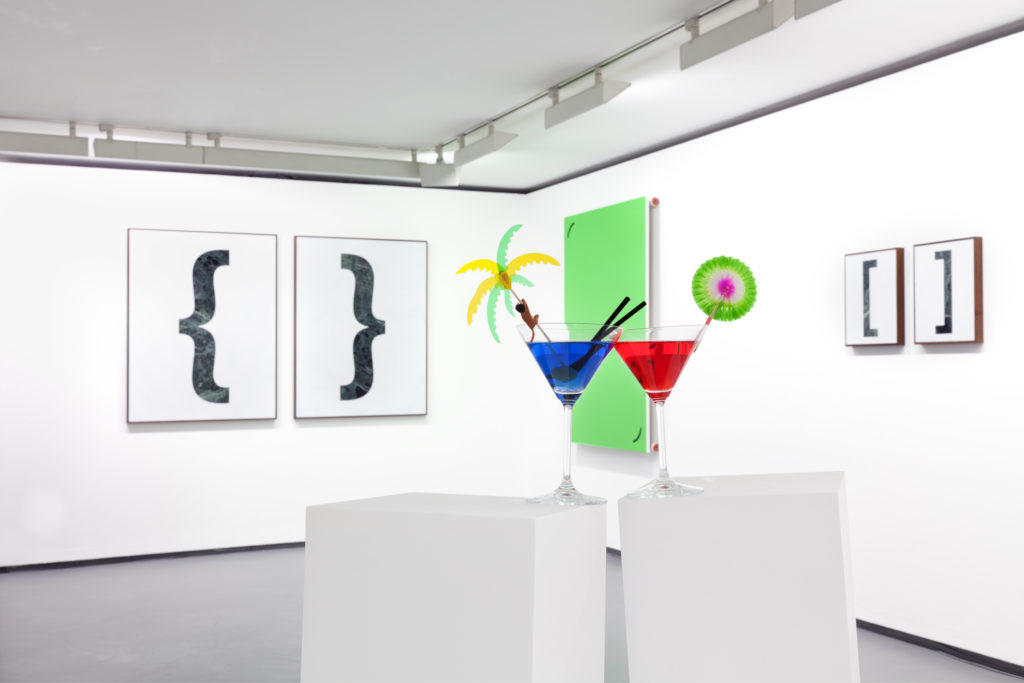
We review the shows you simply cannot miss.

Coline Milliard

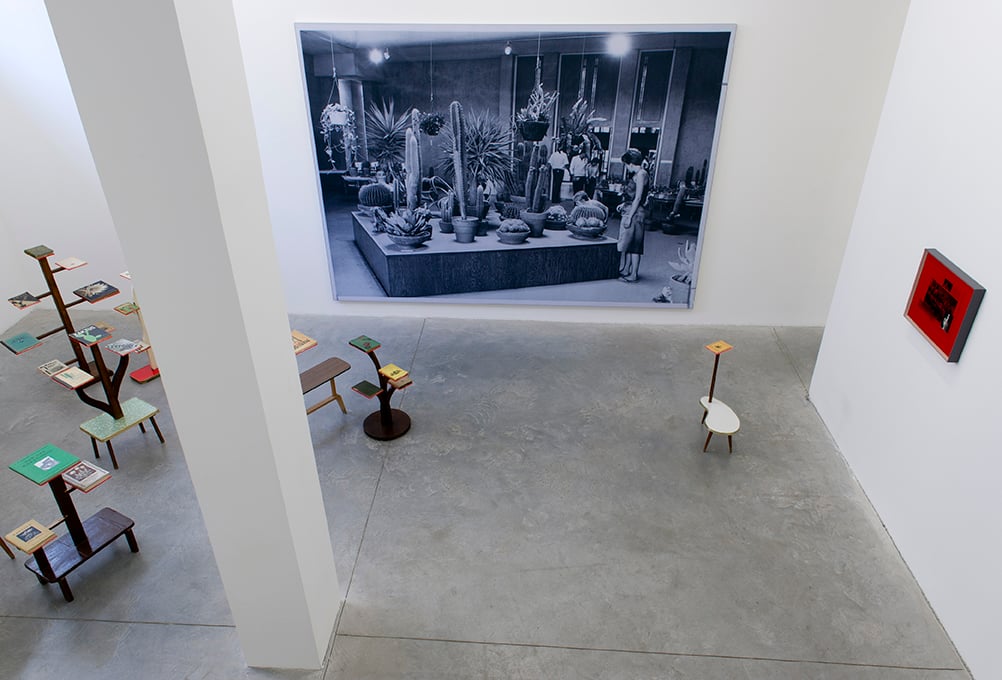
Yann Sérandour, Installation View, Cactus Cuttings, gb agency, Paris, 2014
Photo: Marc Domage
GB Agency, Yann Sérandour, Cactus Cuttings, closes May 31.
It’s a prickly affair, to say the very least. For his third solo show at GB Agency, Yann Sérandour has turned to cacti with the unbridled enthusiasm of the true fan. In a series of sculptures and collages, the artist—best-known for his humorous appropriations of conceptual art’s strategies—looks at the cultural history of the barbed plant since the early days of its domestic cultivation in the 19th century. The Ups and Downs of the Cactus Mania (all works 2014) is a collection of retro pieces of furniture, in which shelves have been replaced by old cactus gardening manuals. Presented together these absurd constructions suggest a strange garden: historical documents form sculptural approximations of the plants whose cultivation they were meant to detail.
Sérandour also obsessively collects vintage photographs of his prickly subject. He arranges them in busy compositions (Cactus Cuttings #1, #2, and #3), like others lovingly pin pictures of celebs on corkboards. Here the cactus undergoes a grafting operation; there it’s the star of an unidentified trade show, somewhere in America in the 1960s. Cacti’s seductive powers prove hard to resist. One can’t help but marvel at the complex patterns drawn by their spines, the rarity of their flowering, which makes an event of each petal, their infinitely slow growth, which is almost a live lesson in patience. The Old Man’s Solo Show is as endearing as if, instead of a single tall cactus on an empty stage, it featured a real old guy finally having his breakthrough performance.
Why Sérandour has picked the cactus over any number of possible themes isn’t really made clear. Is it a reflection on the decorative? Some archival musings on the nature/culture dialectic? Perhaps. In any case, by the end of the visit, the enjoyment is such that it doesn’t need the crutch of a conceptual rationale.
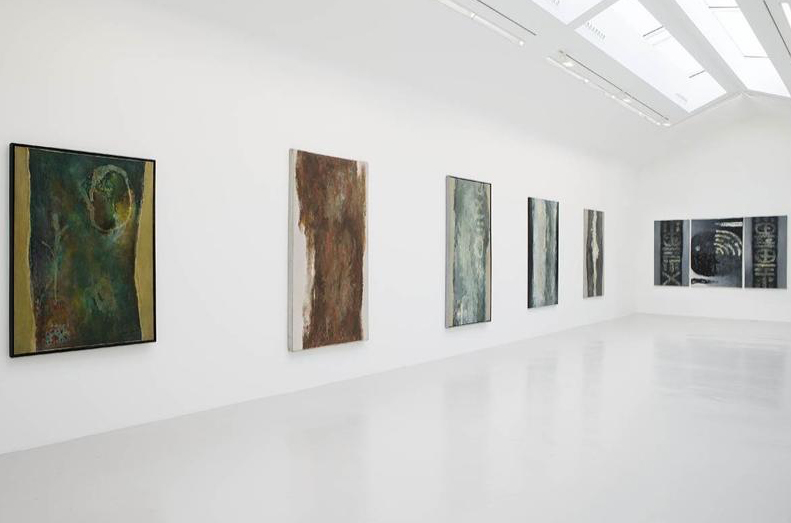
Chen Zhen, Floating Qi
Photograph: Claire Dorn, Courtesy ADAC – Association Des Amis de Chen Zhen
Galerie Perrotin, Chen Zhen, Fragments d’éternité, closes June 7.
Galleria Continua has managed a genuine tour de force with the Chen Zhen retrospective they have curated for all of Perrotin’s spaces in Paris. It would not be less exhaustive or scholarly if it had been organized by the Centre Pompidou, Tate, or MoMA. Gathering over 30 pieces, Fragments d’éternité stages some of the Chinese artist’s best-known concerns: the difficulties of cultural exchange, a back-and-forth between Asian philosophy and rampant consumerism, the ever-growing danger of pollution, and the contrasting understandings of life and the human body according to Chinese and Western medicine. Soon after moving to France in 1986, Chen developed a rich sculptural lexicon, partly informed by ideas of the ready-made and Arte Povera. Found chairs attached facing, or with their backs to, a monumental table (Round Table – Side by Side, 1997) talk of mutual incomprehension and broken dialogue. The sculpture Exciting Delivery (1999) is a monster of breaded tires encrusted with black toy cars and resting on bicycle wheels. It stands as a representation of the ecological catastrophe potentially induced by the shift from bicycle to automobile in China. Equally beguiling is the artist’s project for a Zen garden dated from the year of his death, 2000. It comprises large organs of alabaster, as smooth as sea shells and glowing from within, pierced by the metallic implements of the surgeon. While most of these pieces are well documented, the real surprise of the show is the series of Floating Qi paintings, realized in 1984 and 1985, just before Chen left China. With title such as The Gate of Emptiness, Instant, or Fragment, these expressionist abstractions appear to hold the seeds of the spirituality Chen distilled in his sculptures and installations, when he abandoned painting upon his arrival in Paris. The inclusion is fairly modest but it is significant. With these, the show sheds new light on a little-known facet of the Chinese giant.
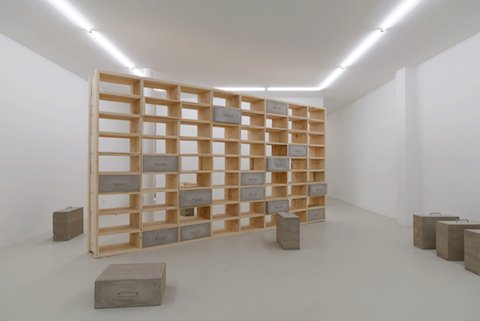
Benjamin Sabatier, Form Work VI (2014)
Courtesy the artist and Jousse Entreprise
Jousse Entreprise, Benjamin Sabatier, Storage, closes May 17.
The paradox is amusing. Benjamin Sabatier’s exhibition Storage is all drawers, but they cannot hold anything. Cast directly inside the wooden armature of the pieces of furniture hosting them, these drawers are made of solid concrete, as heavy, sturdy, and uncompromising as the Brutalist architecture they allude to. Like a leitmotiv, they crop up again and again, on the floor, inside various frames, each time materializing a void that is no longer. One thinks of Rachel Whiteread and her knack for casting empty spaces. With humor and a lightness of touch particularly appreciable considering the materials used, Sabatier’s pieces unwrap such sculptural issues as the relationship between vessel and content, making and traces left, empty and full. The artist’s playful confidence might have to do with the fact that building materials have long been part of his repertoire. Paint tins, tapes, and plaster bags frequently reoccur in the work of this self-proclaimed DIY artist. Here his splicing of the architectural and the domestic results in a fascinating series of purposeless objects. The knowing and slightly convoluted route he traces leads to sculpture at its purest.
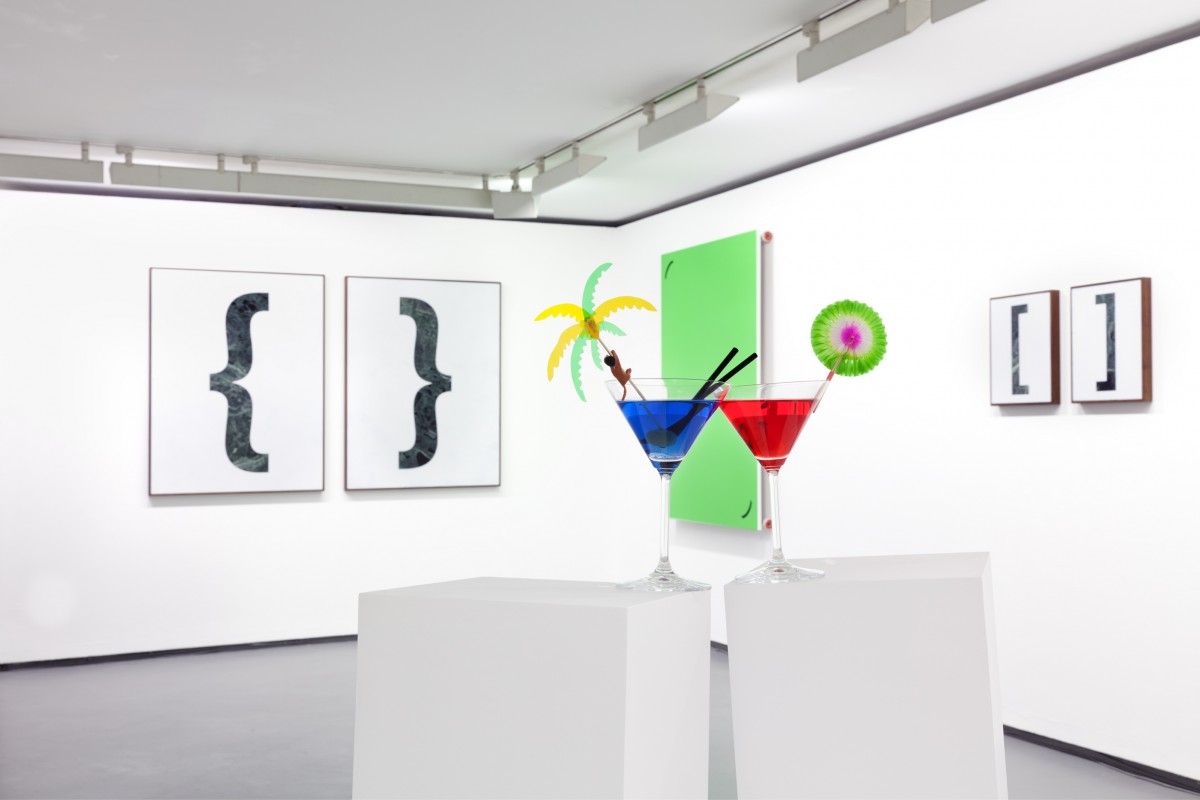
Exhibition view “Drop it like it’s hot” by Gabriele de Santis.
Courtesy of the artist and Galerie Valentin, Paris.
© Sylvie Chan-Liat.
Galerie Valentin, Gabriele De Santis, Drop it like it’s hot, closes May 17.
It’s not often that one comes across true innovation in painting. Although it is the Holy Grail of the vast majority of painters, most end up tinkering in the margins. Not Gabriele De Santis. While fresh and almost funny, his series of paintings on show at Valentin proposes a fairly radical solution to what painting can be. De Santis covers ENGRAVED? plaques of marble with a thin layer of paint, leaving ONLY? punctuation signs in negative. The speed of the painting process simultaneously negates and highlights the eternity symbolically embedded in marble since the birth of Western art. The monochrome expanse, as for instance in the diptych Snooooooooooop (2014), underlines by contrast the richly veined jade stone seen through the punctuation’s aperture. The use of such loaded material might lead some to think of De Santis as a pedant, but the artist would be better described as puckish, mocking artistic conventions and giving them a new contemporaneity. Although it is in many ways classically abstract, the painting ###### (2014) is a case in point. It features hashtags—a little used symbol until the advent of Twitter— pinned on its surface like the butterflies of the digital age. Paint here has been replaced with adhesive vinyl of the kind usually used for skateboards. And there is something of the adolescent transgression here. Two plinths on roller skates (that’s right), each with a colorful cocktail, are so close they seem about to toast. The title? That’s how’s gon’ be, young, wild and free. Not gonna slow down. Up to the max, until we crush, we’re not gonna stop now (2014). A minimal painting, only featuring the negative mark of a parenthesis on marble, bears the moniker That’s whiter than what’s spilling down your throat (2014). For all its formal restraint, De Santis’ use of punctuation isn’t without eloquence. It allows a space for projection, a freedom of interpretation. Frustratingly, this is too often undermined by some of his most heavy-handed titles. One only wishes he would let the paintings do the talking.
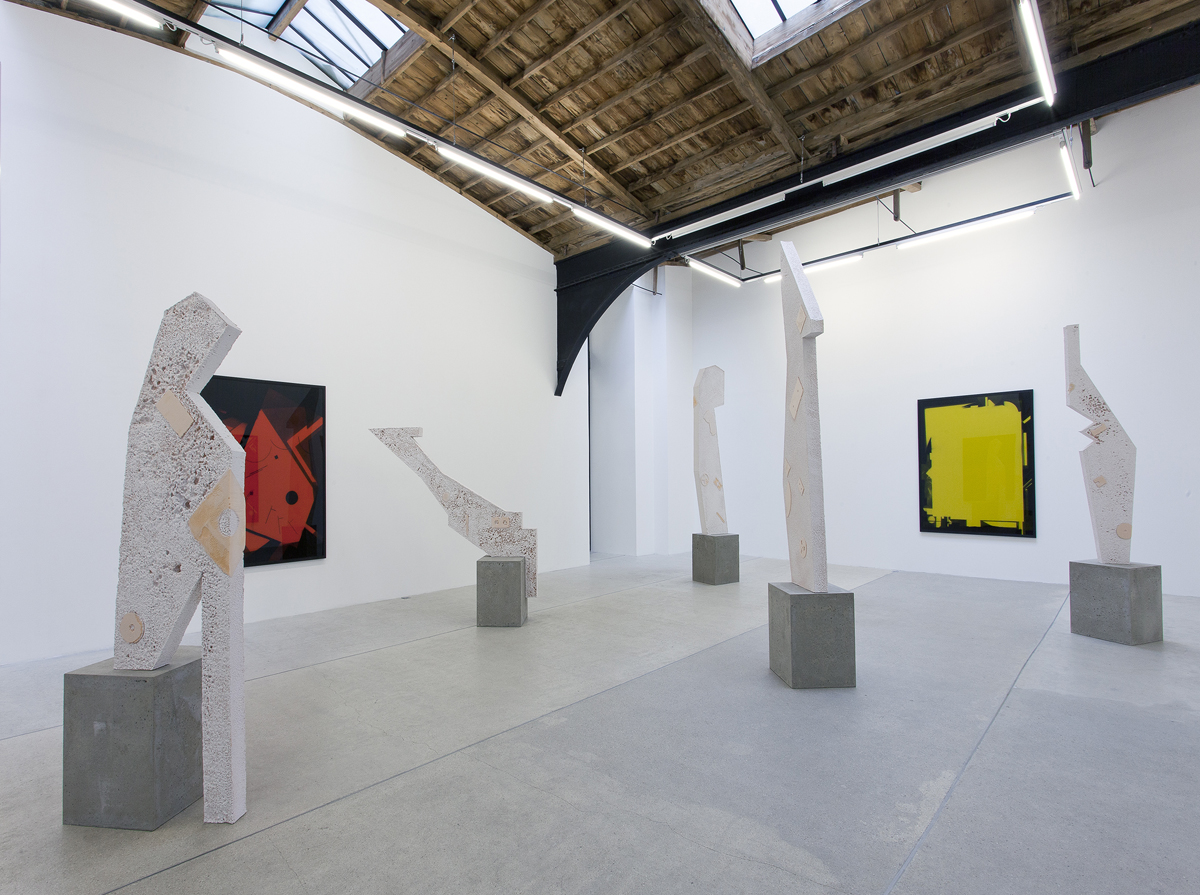
Rainier Lericolais, Fossiles, installation view
Courtesy the artist and Frank Elbaz
Galerie Frank Elbaz, Rainier Lericolais, Fossiles, closes May 31
Rainier Lericolais’ exhibition is saturated with sounds, although none are audible. A keen musician, the artist stages obsolete audio recording devices—cassettes, CDs, LPs—in a series of artworks that can only be described as nostalgic. The large abstract polystyrene sculptures in the main gallery (Untitled, 2014) have been sprayed with paint which has attacked theirs surface except in the few places where a cassette, or a disc, acted as a stencil. These now stand out, as if they had just been brushed free of earth by a dedicated archeologist. The abrupt geometric shapes of these objects bring to mind the early days of abstraction—and indeed such tension between a recent technological past and the early day of Western avant-garde subtends most of the show. Never is this more obvious than in the large Cabinet Phonique (2014), a direct quote of El Lissitzky’s Abstract Cabinet, first imagined in 1925. Reinier fills this modernist display device with some of his own works including Mesmer (2013), a colorful plaster cast featuring fragment of broken LPs, and Ornemental musique, a monochrome variation on graphic notation. In the same room, a wooden wall relief (Journal, 2014) includes a magnetic tape holding the recording of sounds collected during the installation, mounted on a small metal bracket like a precious tribal artifact. The body of the cassette itself is embedded in the work’s frame. Elsewhere, a balalaika has been painted and polished, turned into an intriguing abstraction. Yet the memory of its past life continues to inhabit its muted soundbox, as if only waiting for the right musician to unlock musical treasures. It might be that this state of uncertainty is what Lericolais’ work is truly about: the fluid connections linking what things are, what they were, and the memories they bring in their wake.
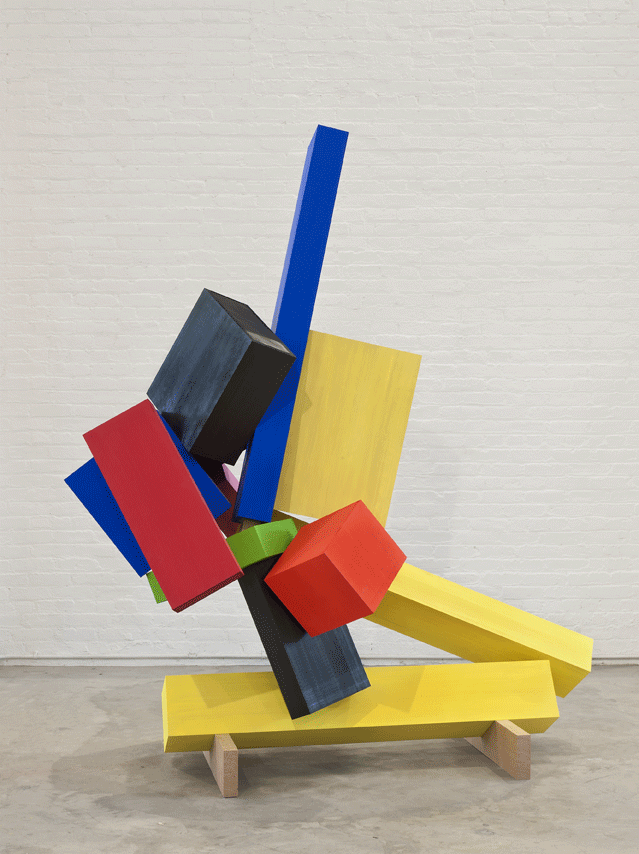
Galerie Karsten Greve, Joel Shapiro, Wood Plaster Paint, closes August 23.
In Wood Plaster Paint, the practice of celebrated American sculptor Joel Shapiro reveals itself as at once remarkably consistent and characterized by a daring sense of experimentation. Shapiro relentlessly investigates the properties and behavior of geometric volumes in space, a quest anchored the phenomenological approach of the late 1960s. His assemblages of geometric forms seem to ask such questions as: how can a sculpture exist in a given space? How does it respond – or appear to respond – to the body of the visitor moving in the same space? How much of its reality is intrinsic, and how much is pure perception? Despite these theoretical concerns, Shapiro never departs from a certain lightness of touch, a sense of joy, of humor even, greatly enhanced by the bright hues he uses to dress his constructions. Vibrant greens, turquoises, and crimsons ricochet from floors to walls, where some of the pieces are hung like high-reliefs. This, added to the impression of precariousness of some of these pieces, which seem to be only just holding together, infuses the show with an almost palpable dynamic tension. Phenomenology is fun.